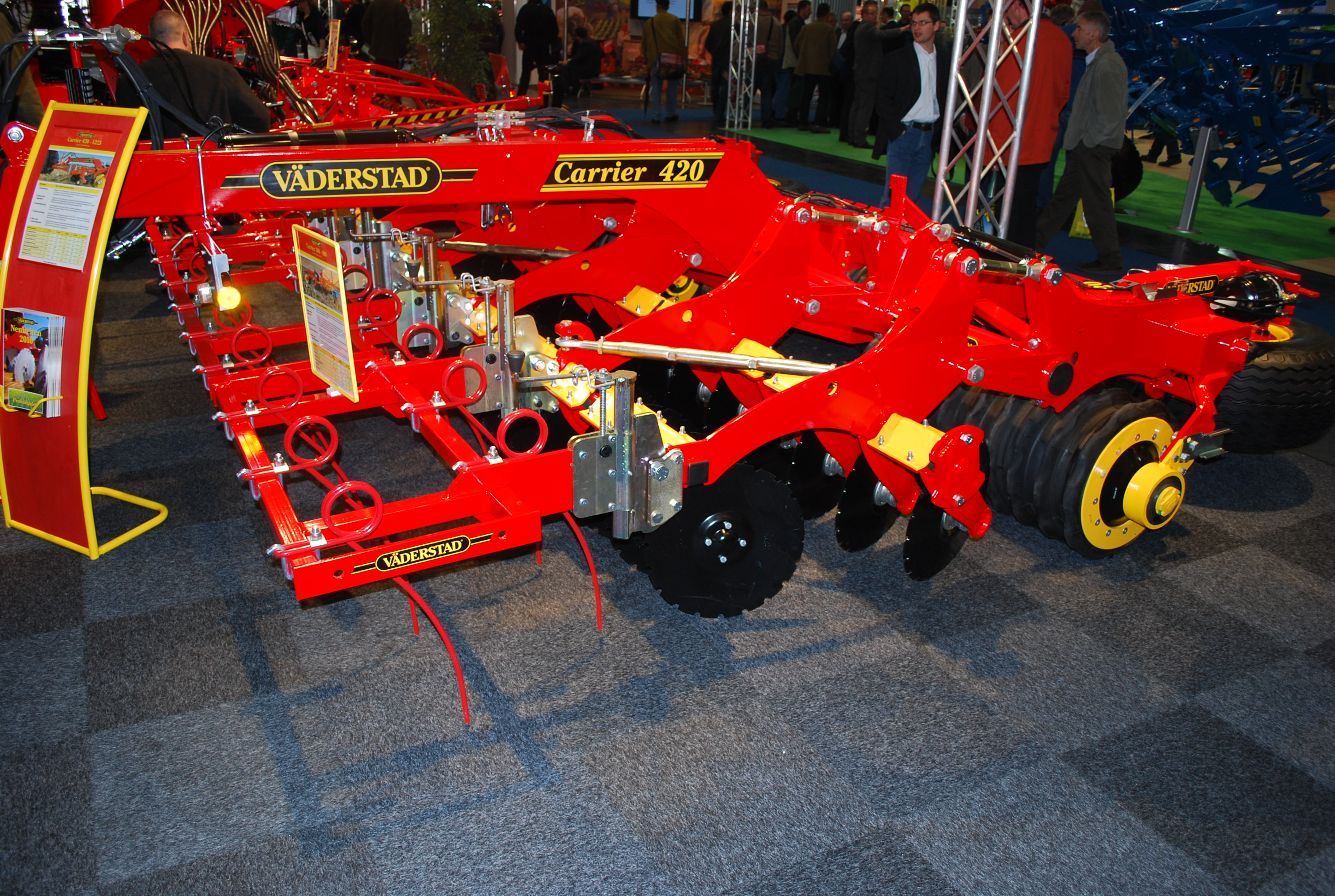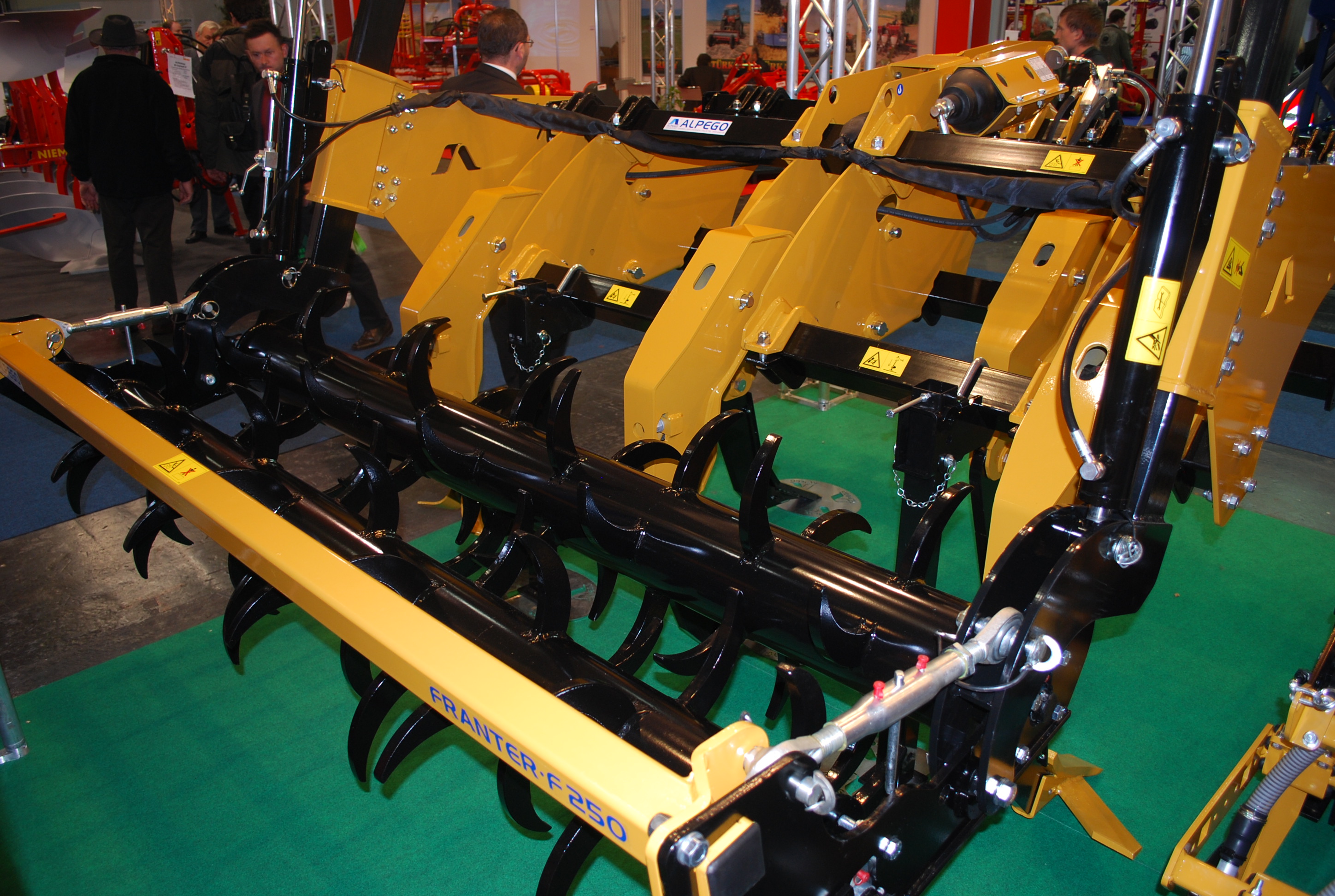POTTINGER displayed its Terradisc compact disc harrows, which were developed for stubble cultivation over large areas, and for general seedbed preparation. Themachines are designed for shallow preparation with intensive mixing, and are offered in working widths of 16 ft., 5 in. and 19 ft., 8 in. Anders Hansen says North America is becoming more and more important as a market in recent years and “we’re now ready to harvest the fruit from the trees we’ve planted.” Pottinger may target North Dakota, South Dakota, Nebraska, Kansas, Kentucky and West Virginia with its hay-and-forage and tillage equipment. “We can deliver parts and service and we’re in a good position to make it work,” Hansen says.
GREGOIRE BESSON has a small presence in North America, but that might be changing. Bill Vermilyea told Farm Equipment that the company is building a pulled-hinge plow for U.S. market for big tractors, since many other manufacturers are not making them anymore. The machines are being built in Canada. “The milk-price situation is not good, and our production costs are higher right now,” Vermilyea says.
It was a busy show for German seeding and soil cultivation specialist LEMKEN, which displayed its Gigant 12/1200 system carrier and Rubin compact rotary cultivators, which can be used for shallow, fast and intensive one-pass work turning a harvested field into a seed bed. Christian Jungmann says Lemken has established four sales “agencies” to work with 9 dealerships in eastern Canada, and the company is looking for more dealers there – especially those who can offer a high level of product knowledge, service and availability of spare parts to customers. The ability to host equipment demonstrations is also important.
Lemken hopes to start putting a distribution and dealer network together in 2010, focusing on corn-growing areas like South Dakota, North Dakota, Minnesota, Iowa, Ohio, Wisconsin and Michigan. “We will have agents to support these dealers,” Jungmann says. There is a difference, Jungmann said, in how land is tilled in the U.S. and Canada and that played a role in how the Canadian market developed.
Canadian farmers are often more open to spending the money for and using one-pass tillage systems, where a few different processes being done at once, while U.S. farmers tend to use more than one pass and are more price conscious. But Jungmann believes there will be a shift in mindset among farmers to saving labor costs and reducing fuel consumption. “But they must accept that it may be at a higher price” in terms of the equipment costs.”
VADERSTAD showed its line of Carrier soil cultivators for stubble cultivation, seedbed preparation, straw harrowing and furrow leveling. The implement hasworking widths of 9-40 ft. and has applications for wheat and cereals, and possibly corn. Vaderstad is taking a serious look at North America for selling equipment meant for minimum-till applications, says Clas Asknert. “We are looking for dealers and we’re just listening and learning right now. We have machines for sure that will fit in North America. It’s a tough market and we have to be prepared. We like to take things step by step, and providing service to end users is very important to us.”
ALPEGO s.r.l. showed its Franter 250 Spader, which is beginning to sell in the vineyard areas of California. The machine’s spading technology is popular for its ability to fracture the soil and let water penetrate without leaving channels likesome rippers do, says Maria Rosa Bankston. Alpego has bigger ambitions in North America if a suitable distributor can be found, and the company is still working on that, Bankston says. Alpego is building new plant in Vicenza, Italy, that will have 38,000 square feet of covered space when it’s completely finished. ALPEGO is making about 3,000 machines a year. The company’s lineup includes power harrows, subsoilers, combined seed drills, rotary tillers and flail mowers.
AGRISEM showed its new Maximulch tillage tool, which features two rows of independent discs and a row of loosening blades that can be placed in different orders. “It’s difficult to know in advance what will be the best combination. Depending on the soil type and previous crop, the best position of the blades will be in the front, in the middle or at the rear,” says export manager David Guy of the Maximulch, which comes in fixed or folding units.
The Maximulch, for tractors 150-350 hp, was one of 10 new products Agrisem unveiled at Agritechnica. Guy says Agrisem’s initial expansion in Eastern Europe has gone well withproducts being distributed in 32 different countries, and now the company can turn its attention to North America — with a product lineup that has suitable options for farmers here.
The biggest challenge, Guy says, is the current currency exchange rate between the dollar and euro and its effect on equipment costs for potential end users. The company is talking to dealerships here about possible solutions, including having the frames built and implements assembled somewhere in North America. “It should be easy for us to find a partner in North America because we have no factory,” he says. “When we created the company 15 years ago, we felt the need to do the difficult job of designing and creating the new machines. This is why we have no factory today.









